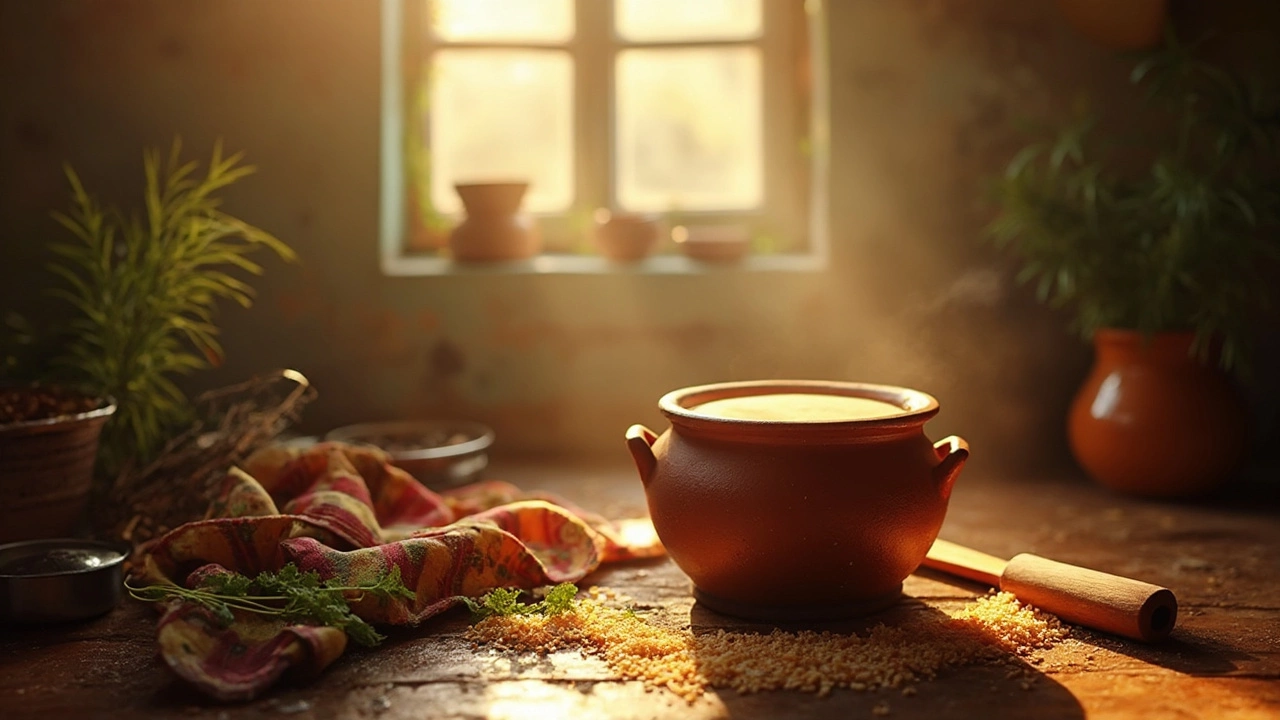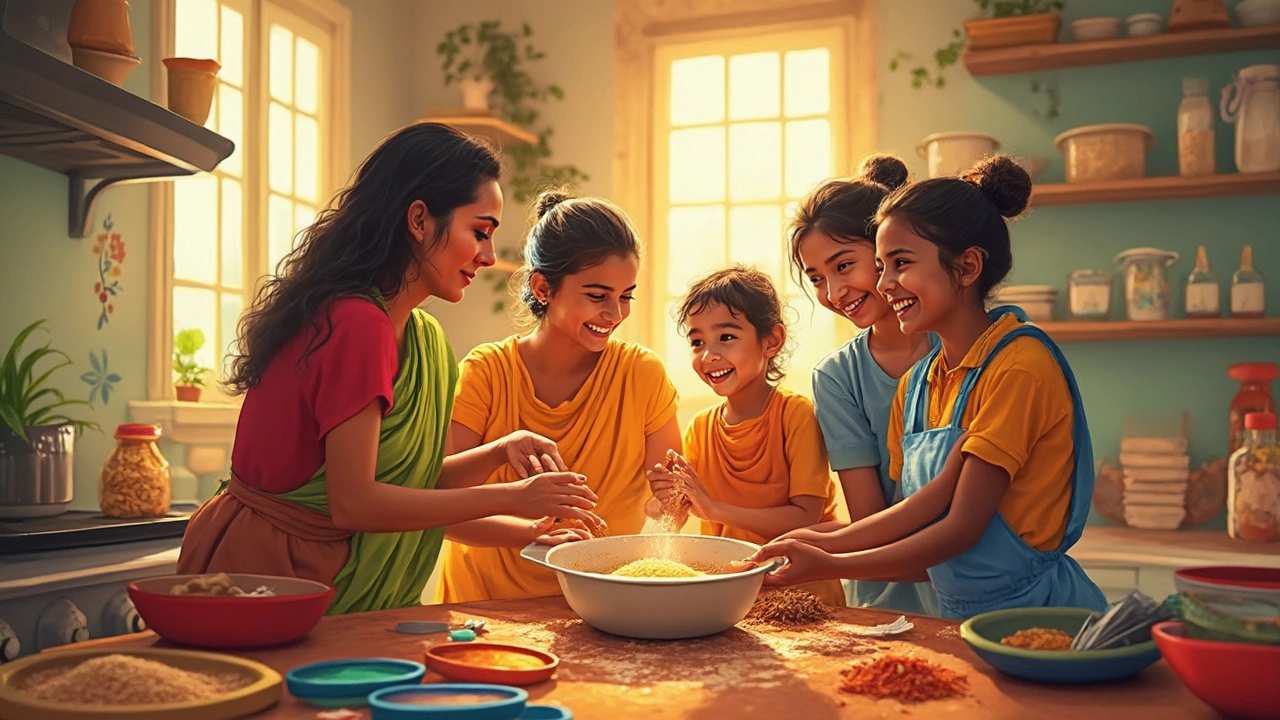Speed Up Your Dosa Batter Fermentation: Simple Natural Hacks
 Feb, 16 2025
Feb, 16 2025
So, you're tired of waiting forever for your dosa batter to ferment properly, right? Well, the secret to speeding up this process naturally might just be simpler than you'd think. First off, understanding what fermentation needs—like warmth and the right environment—is half the battle. If you've ever cursed a cold kitchen for your batter mishaps, you're not alone.
Temperature plays a massive role in how quickly your dosa batter ferments. If your kitchen is too chilly, your batter won't develop those lovely bubbles fast enough. Just like how we love sunbathing, so does the batter. Place it in a warm spot, maybe a sunny window sill, and you'll be giving those little yeast cells a head start.
And get this: the water you use to rinse and soak your rice and dal can make a difference. Using slightly warm water, instead of water straight out of the fridge, gives the fermentation process an edge. It's like giving your batter its morning coffee—instant energy!
- Understanding Dosa Batter Fermentation
- The Role of Temperature
- Sunlight: Nature’s Fermentation Booster
- Optimizing Soaking Techniques
- Use of Natural Fermentation Aids
- Check the Water Quality
Understanding Dosa Batter Fermentation
Fermentation is the magic that transforms ground rice and dal into a bubbly, airy batter ready for cooking into delicious dosas. But what exactly is happening in that batter mix?
When you grind your rice and urad dal into a smooth paste, you're creating a perfect environment for yeast and lactic acid bacteria to thrive. These microscopic organisms feed on the sugars present in the rice and dal, producing carbon dioxide and alcohol as byproducts. It's the carbon dioxide that creates those bubbles, making the batter rise and turn into those soft, fluffy dosas we love.
Factors Influencing Fermentation
A few critical factors can tip the speed and quality of your batter's fermentation process:
- Temperature: Warmer temperatures accelerate fermentation. A cozy 25-30°C (77-86°F) is usually ideal.
- Time: With the right conditions, fermentation usually takes 8-12 hours. But colder climates might stretch this period.
- Proportions: Standard ratios like 3:1 or 4:1 for rice to urad dal work wonders. It ensures enough starch for yeast to munch on.
- Water Quality: The type of water you use can influence fermentation. Avoid chlorinated water as it may hinder yeast activity.
Fun Fact
Did you know natural fermentation boosts the batter's nutritional value? It increases vitamins B and C and aids in digestion!
Understanding these basics gives you a head start in mastering the art of dosa batter fermentation. Once you get these right, the rest is just tweaking to suit your taste and environment. Happy dosas await!
The Role of Temperature
Temperature is a game-changer for getting that dosa batter to ferment quickly. Trust me, if you've been leaving your bowl of batter in a cold corner of the kitchen, you're doing it a disservice, and missing out on speedy results. The ideal temperature zone for most homemade fermentations is between 25°C to 32°C (77°F to 90°F). That’s because the friendly bacteria and yeast that drive the fermentation thrive at these temperatures.
Does your kitchen get chilly at night? Consider an alternate approach. Wrapping the container with a warm towel can help. Some folks even swear by placing it in a microwave or oven (turned off, of course) as it provides a consistent warm environment.
Little Changes with Big Impact
During cooler months, a smart trick is to use a preheated oven (not hot, just slightly warm) or placing a bowl of hot water nearby to keep the surrounding air warm. It's all about improvising with what you have. Getting creative with these little changes can reduce the wait time significantly!
Outside Temperature Influence
If you’re lucky to live in a hotter place, nature has got your back. In places where the sun is blazing (hello, Indian summers!), simply putting the batter out in the sun for an hour or so can give it that initial boost it needs. Just watch out and don't let it get too hot lest it starts cooking!
To sum it up, ensuring a cozy environment for your batter dramatically affects fermentation speed. Remember, an unhappy batter at the wrong temperature means no fluffy dosas, and nobody wants that. So, play around until you find what clicks with your kitchen setup!
Sunlight: Nature’s Fermentation Booster
Imagine your dosa batter soaking up some good old sunlight, just like you enjoy a sunny day at the beach. Placing your batter in direct sunlight can be a game-changer when it comes to speeding up fermentation. Here’s why it works.
How Sunlight Accelerates Fermentation
Sunlight naturally warms up the surrounding area and the container holding the batter. This increased warmth is essential because the organisms responsible for fermentation, like yeast, thrive in warm conditions. When you pop your batter in a sunny spot, you allow these little helpers to work faster, reducing the time it takes to get your batter ready.
Best Practices for Using Sunlight
So, how do you do this effectively?
- Pick the Spot: Find a window or balcony where the sun shines through for a few hours a day. It doesn’t have to be the fiercest noon sun—a couple of hours in the morning or late afternoon works great.
- Use a Transparent or Light-Colored Container: This helps absorb sunlight better, ensuring even warmth throughout the batter.
- Cover It Adequately: While you want the warmth, you don’t want dust and debris making friends with your batter. Use a clean cloth or a loose lid.
A Word of Caution
Don’t go overboard and place your batter in blazing sun all day. Too much heat might dry it out on the top. It’s all about finding that sunny sweet spot.
For some quick context, homes in regions with more consistent sunlight have been naturally using this method for generations—it's a tried-and-true method passed down through families in sunnier parts of the world.
With just a little strategic sunlight, you can enjoy perfectly fermented dosa batter much faster. Who knew the sun could be such a handy kitchen assistant?

Optimizing Soaking Techniques
Alright, let's talk about a game-changer in the world of dosa batter: soaking techniques. It's more important than it seems, trust me. The way you soak your rice and dal can drastically speed up fermentation, leading to the fluffiest dosas.
Use Warm Water
First things first, toss out that cold water. Using lukewarm water for soaking does wonders. It kickstarts the enzymatic process, helping the grains soften faster. Imagine it as giving your grains a nice warm bath.
Separate Soaking
Here's a neat trick: soak rice and dal separately. Why? Each has a different soaking time, and this method ensures they both reach optimal consistency. Once soaked, grind them together, and you're setting your batter up for success.
Add a Little Magic
Wanna up your game? Try adding a teaspoon of fenugreek seeds to the dal while soaking. Not only do they bring a ton of health benefits, but they also naturally aid fermentation.
- Scoop a few seeds into your dal.
- Let them soak along with the dal.
- Grind them together to incorporate nature's secret weapon into your batter.
Remember, the right soaking technique isn't just about timing—it's about setting the stage for a fermenting success story.
Use of Natural Fermentation Aids
Ever wondered if there are some kitchen hacks to get your dosa batter to ferment faster? Well, the secret lies in using natural aids that are right under your nose! These aids not only quicken the process but add a subtle depth of flavor to your batter as well.
The Magic of Fenugreek Seeds
First up, fenugreek seeds (methi). These little guys are not just for flavor; they actually help enhance the fermentation process. Adding a teaspoon of soaked fenugreek seeds to your batter works wonders by increasing the production of carbon dioxide bubbles, which promotes fluffiness.
"Adding fenugreek seeds is like giving your batter a nice, cozy blanket of warmth," says Chef Anita Priya, known for her Indian culinary expertise.
Benefits of Poha
Ever tried using poha (flattened rice)? Adding a handful of soaked poha to your dosa batter can be a gamechanger. It softens the texture and can speed up fermentation, thanks to the sugars present in it.
A Dash of Yogurt
In some households, a tablespoon or two of yogurt is added to the batter. The beneficial bacteria in yogurt act as a catalyst, making the process quicker while enriching the flavor profile.
Experimenting with Cooked Rice
Don't be surprised if you find cooked rice as an ingredient in some recipes. This is a trick borrowed from generations—cooked rice adds starch, aiding in fermentation while contributing to the batter's smoothness.
To summarize, here's how you can use these natural aids effectively:
- Add 1 teaspoon of soaked fenugreek seeds to your rice and dal before grinding.
- Add a handful of washed poha just before you grind the soaked ingredients.
- Mix in 1-2 tablespoons of yogurt after grinding to initiate quicker fermentation.
- Incorporate a small amount of cooked rice while blending for better texture.
Incorporating these natural aids might just be the hack you need to nail that perfect dosa every time. Not only will it enhance the batter's quality, but it could also save you precious hours waiting for those beautiful bubbles to appear!
Check the Water Quality
Believe it or not, the water you use in your dosa batter can make or break your fermentation process. Quality really counts here. If you’ve ever wondered why your batter doesn’t bubble up just right, your water might be the culprit.
First things first, tap water can vary greatly. Depending on where you live, it might contain chemicals like chlorine, which can slow down or even mess up the fermentation process. If that's the case, try using filtered or boiled water (once it’s cooled) instead to prepare your batter.
Another tip is checking the mineral content. Hard water, which has lots of dissolved minerals, can be less effective than soft water. While most city water supplies should be fine, a basic mineral test kit from a hardware store can do the trick if you’re unsure about your water quality. A simple online search for your city's water report might also help you figure out what you're dealing with.
Additionally, use warm water when mixing your batter. Not hot—just warm. Cold water can delay fermentation and is an easy fix if you’re in a hurry to enjoy those crispy dosas.
Let’s look at an example: if you're in Mumbai, the water generally has a decent balance but using boiled water can be a good practice to avoid contaminants.